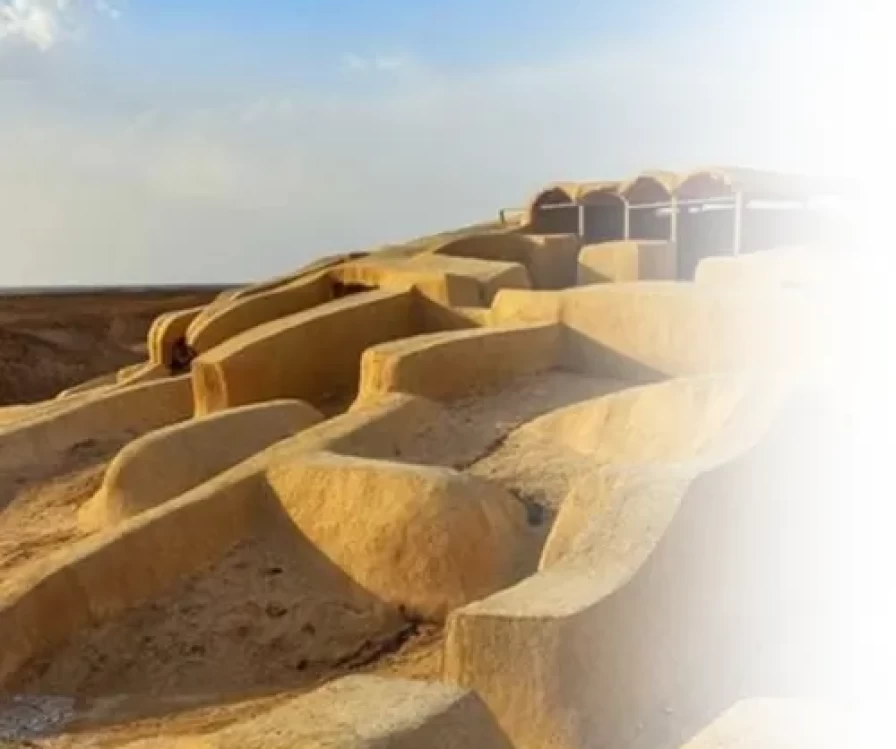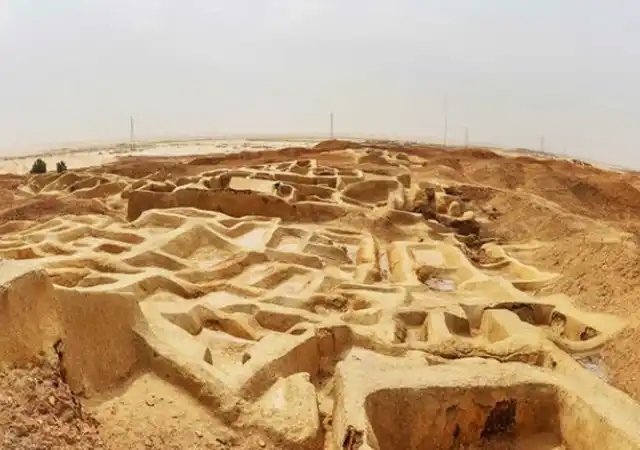
Shahr e Sukhteh





Burnt City
The Burnt City or Shahr-e Sukhteh of Sistan is the name of the remnants of a very ancient metropolis in Hamun County. This city was built on the confluence of the waters of the Helmand River flowing into Lake Hamun. This city and its civilization are contemporaneous with the Bronze Age and the Jiroft civilization. Some, however, consider the Burnt City to be part of the Elamite artifacts. These questions will certainly be answered in the future with further excavations. In 2021, excavations led by Seyyed Mantoor Seyyed Sajadi resulted in the discovery of a Proto-Elamite accounting tablet. Currently, the Burnt City is listed as a UNESCO World Heritage site and, with a history of 5,000 years, is considered one of the oldest cities in Iran and the world.
This ancient site is located in the Lotak district of the central part of Hamun County, 8 kilometers from the new city of Ramshar, 14 kilometers from the village of Lotak, and 30 kilometers from Mohammadabad, the center of Hamun County, on the road from Mohammadabad to Zahedan, and 50 kilometers from Zabol. The Burnt City is currently situated within the administrative divisions of Hamun County.
The Burnt City is considered a historical and archaeological site from the Bronze Age and contemporaneous with the Jiroft civilization in Sistan, Iran. Colonel Beat was one of the first to mention the existence of this city during the Qajar era. Based on the ash remains found around the city, he mistakenly named it the Burnt City, thinking it had been destroyed by fire, unaware that it was an industrial city and that the ashes were byproducts from its industrial furnaces, discarded by workers around the kilns, creating visible mounds today. The Colonel was misled into believing that the city had burned down. Another point regarding the ashes is that after the city's decline, nomads came to this area, dug pits in the ground, and lit fires in them, which over time created mounds of ash that further deceived the Colonel and others in later centuries.
The Burnt City spans an area of 280 hectares and consists of five main sections:
1. Residential area in the northeast
2. Central areas
3. Industrial zone
4. Memorial buildings
5. Cemetery
Eighty hectares of the Burnt City are designated as residential. The archaeological site of the Burnt City is situated 18 meters above the surrounding area. Findings indicate that, unlike today, nature was much kinder to the people of this land 5,000 years ago, and the region was much wetter and more fertile, with a more suitable vegetation cover. There were abundant willow, maple, and poplar trees. The Hamun Lake was a large and well-watered lake around 3200 BC, fed by several rivers, and similar to the Nile delta in Egypt, the floodplain of these rivers, especially the Helmand, would fill with floodwaters during the rainy season and be used for cultivation.
These alluvial deposits led to bountiful harvests, resulting in significant wealth accumulation in the region, which eventually led to its industrialization. Excavations have shown that there were many canals and streams in this area, likely used for irrigation of the Burnt City's fields. From 1997 to 2003, 14 random test pits were excavated in an area of 2300 meters of the city's cemetery, resulting in the discovery of 310 graves. During the excavations, it was determined that some of the people of the Burnt City were buried in shrouds made of fabric. In some graves, traces of cloth were found on the bodies of the deceased. The fabrics appear in three different forms in the graves:
1. As shrouds, wrapping the deceased.
2. As garments and coverings.
3. The floor of the grave was carpeted, and the deceased was placed in it with clothing.
Pottery artifacts were found in all graves, and in some tombs, items made of stone, wood, and fabric, as well as precious stones, gold, and silver, were also discovered.
As mentioned, the Burnt City was recognized as an industrial city with various ancient arts and crafts. In the sixth season of excavations, interesting samples of jewelry and related industries were discovered. In previous seasons, many beautiful pottery and jewelry artifacts were also found. The necessary fuel for industries was provided by the wood from local trees, and the ashes from these trees are still visible throughout the city. In one grave, beads and necklaces were found, made from lapis lazuli and gold tubes.
Artists used primitive tools to hammer gold into sheets less than a millimeter thick, then rolled them into delicate tubes, alternating them with pre-made lapis lazuli beads, threading them together to create unique necklaces. In the Burnt City of Sistan, various pottery and stone vessels, mosaic works, and types of fabric and matting were found, indicating the presence of several industries, especially advanced textile production. So far, 12 types of single-color and multi-color fabrics, fishing hooks, and dozens of other items have been discovered. Excavations have shown that the people of the Burnt City wove baskets and mats using reeds and bulrushes from nearby marshes and sometimes used these reeds for roofing their buildings. Fishing and weaving fishing nets were also among the occupations of the people of the Burnt City.
The Burnt City had a very advanced civil organization. Excavations have shown that some houses in this city had plumbing and sewage systems, with water supplied to homes through ceramic pipes, and wastewater collected and directed outside the city through these same pipes. Other evidence indicates the existence of urban planning in the Burnt City.
Only one tablet inscribed in Elamite script has been found in the Burnt City, but seals indicate trade connections and economic control of the region by its inhabitants. The people of Sistan maintained contact with the inhabitants of Mesopotamia through land routes and trade routes in the Persian Gulf, transporting lapis lazuli from Afghanistan to the people of Mesopotamia and Egypt. It is worth noting that the people of Sistan and the Helmand plain had little dependence on the Nile and Mesopotamian plains, developing their own civilization independently, comparable even to those of the two mentioned civilizations.
Carbon dating and remnants of uranium-238 have shown that the Burnt City was inhabited between 1900 and 2900 BC. During this time, the people of this area managed to establish a large and prosperous city where they engaged in various handicrafts, formed an organized government, adhered to a unified religion, and established extensive trade and cultural relations with neighboring regions.
Initially, the people of the Burnt City were very close to the people of Turkmenistan, and towards the end of their civilization, they became closer to the people of Punjab. Eventually, with the decrease of water in the Helmand River and possibly due to natural disasters, they migrated to Punjab and integrated into the Punjab civilization.
Among the discovered artifacts, lapis lazuli and turquoise indicate the advancement of industry and trade in this area. By examining the graves of the Burnt City, one can point to an epidemic that caused the death of many children and adolescents, which may have contributed to the decline of this civilization. Archaeological research has also shown that many inhabitants of the Burnt City were engaged in occupations not related to food and sustenance. Pottery, mat weaving, stone carving, and the production of jewelry and ornaments from lapis lazuli or turquoise occupied some of the artisans of the Burnt City.
In a general classification, the discovered artifacts can be divided into the following groups:
1. Decorative items
2. Ritual items
3. Items related to occupations
4. Items used in daily life
5. Food materials
For the first time, an artificial eye was found in the Burnt City. The composition of this eye is not entirely clear, but it appears to be made from a non-natural substance mixed with fat, stabilized in the eye socket by a string.
The discovery of a game similar to backgammon is another wonder of this city. This game dates back 4,600 to 4,700 years, and for the first time, the game board with ancient rules was deciphered and reconstructed, likely played during that time.
In the Burnt City, a pottery cup was found with an image of a goat drawn on it that appears to move closer and further away as the cup is rotated, creating an animation-like effect. This technique is similar to those used in animations today, involving a series of frames that follow each other quickly. This cup is preserved in the National Museum of Iran in Tehran.
In one of the graves of the Burnt City, the skeleton of a teenage girl was found with signs of brain surgery on her skull. There are various theories regarding this surgery. What is clear is that the volume of this girl's skull is larger compared to other women and girls found in the Burnt City. Researchers believe that this girl suffered from hydrocephalus. This 13-year-old girl survived for several months after the surgery, as there are clear signs of healing in the bones, but the cause of her death is unknown. She was found in a mass grave alongside 13 other skeletons.
Visiting the Burnt City may not be accessible to the general public and tourists, but if you have the time and ability to travel to this historical site, our specialized team at Sana Persian is ready to arrange your trip. We hope to see you in Iran, Sistan and Baluchestan, at the Burnt City in the near future. Looking forward to your visit!
Contact Us
+989054577261